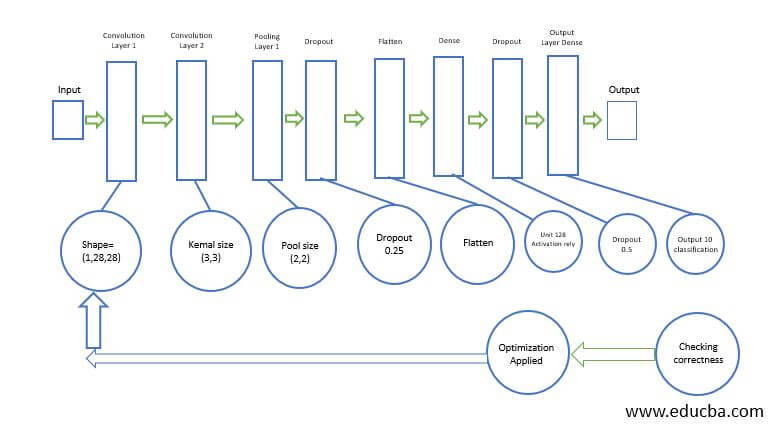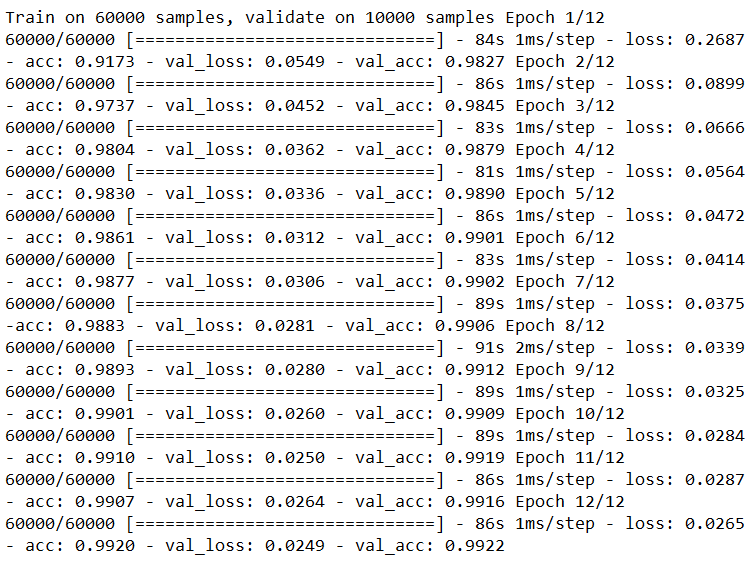Updated June 20, 2023

Introduction to Keras CNN
Keras CNN stands for the Keras convolution neural network, which consists of various layers, including conv1D layer, conv2D layer, conv3D layer, separable Conv 1D layer, separable Conv2D layer, depthwise conv2D layer, conv2D transpose layer, and Conv 3D transpose layer. This article will look at Keras, which is Keras CNN. We will learn more about it by looking at the subtopics, including What Keras CNN is, How to use Keras CNN, Uses of the Keras CNN model, examples, and Conclusions about the same.
What is Keras CNN?
Keras CNN is the neural network that uses convolution, a mathematical operation carried out on matrices. The neural network consists of convolution layers containing the filters, similar to the matrices containing numbers.
For the convolutional neural network, we need to pass specific input images, and after the filters are applied, convolution happens, and the output images are produced. The process of convolution contains the following things –
- We must overlay the filter we want at a particular location on top of the specified input images.
- After that, we need to calculate element-wise the values inside the filter matrix and the corresponding values inside the image.
- We must sum the products we got by elementwise multiplication, our final value for the pixel inside our output image.
- The above three steps are repeated for every location.
How to Use Keras CNN?
We can use it to classify images in CIFAR, which involves training and creating our keras model using sequential API. The steps required to use the Keras CNN for creating and training the model are as mentioned –
- Importing all the necessary libraries and classes. One of the important ones is Tensorflow at the top of the program.
- Prepare the raw input data by downloading the CIFAR10 data set containing almost ten classes with more than 60000 images in colored format. Out of this testing, images have an approximate count of 10000, while training ones are around 50000 images.
- The next step is to verify the data set and check if it’s correct.
- We will now need to create a base of convolution by following a common pattern of having a stack of layers like conv2D and max-pooling 2d.
- We will now add one more layer at the top, a dense layer for completing our model. This layer will get the inputs from the output of all the other tensor layers, which will be responsible for performing classification.
- Compiling the model and then training the same will be our next step which can be easily done using the methods of .compile() and .fit() for compilation and training, respectively.
- Now we can evaluate the model by using evaluate() method for plotting and labeling the values, which will give the final results of the model.
Uses of Keras CNN Model
The features and uses of keras CNN are found immensely in the classification of CIFAR images. Below are the features of Keras CNN, which are convolutional neural networks.
- The value of the layer of input is 1,8,28.
- Conv2D forms the first layer of the model containing a total of 32 filters along with the presence of the relu function used for activation. In addition, it has the kernel size set to (3,3).
- There is a presence of one more conv2d layer, which acts as the second layer having a relu activation function along with 64 filters in it with a total size of kernel set to (3,3).
- The third layer of this neural network is Max pooling with (2,2) as the size of the pool.
- The flattened layer used for getting all the inputs flattened into one dimension is present in the fifth layer.
- The sixth layer is made up of 128 neurons and is a dense layer that also contains the relu activation function in it.
- The Dropout layer forms the seventh layer of the neural network, with a value of 0.5.
- Our CNN’s final and 8th layer comprises a softmax activation function and contains ten neurons.
- We will make use of the loss function of categorical cross-entropy.
- The optimizer that will be used will be Ada delta.
- Metrics for our neural network will be accurate.
- The batch size is 128.
- The epoch value for the count of iterations of training is 20.
Example of Keras CNN
Code:
//importing the necessary classes and libraries
import keras
from keras.datasets import mnist
from keras.sampleEducbaModels import Sequential
from keras.layers import Dense, Dropout, Flatten
from keras.layers import Conv2D, MaxPooling2D
from keras import backend as sampleEducba
import numpy as np
// Loading the mnist dataset for the sample purpose
(xValueForTraining, yValueForTraining), (xValueForTesting, yValueForTesting) = mnist.load_data()
//modify the existing data set for our requirement of the sampleEducbaModel.
rowsOfImage, columnsOfImage = 28, 28
if sampleEducba.image_data_format() == 'channels_first':
xValueForTraining = xValueForTraining.reshape(xValueForTraining.shape[0], 1, rowsOfImage, columnsOfImage)
xValueForTesting = xValueForTesting.reshape(xValueForTesting.shape[0], 1, rowsOfImage, columnsOfImage)
input_shape = (1, rowsOfImage, columnsOfImage)
else:
xValueForTraining = xValueForTraining.reshape(xValueForTraining.shape[0], rowsOfImage, columnsOfImage, 1)
xValueForTesting = xValueForTesting.reshape(xValueForTesting.shape[0], rowsOfImage, columnsOfImage, 1)
input_shape = (rowsOfImage, columnsOfImage, 1)
xValueForTraining = xValueForTraining.astype('float32')
xValueForTesting = xValueForTesting.astype('float32')
xValueForTraining /= 255
xValueForTesting /= 255
yValueForTraining = keras.utils.to_categorical(yValueForTraining, 10)
yValueForTesting = keras.utils.to_categorical(yValueForTesting, 10)
// Model creation
sampleEducbaModel = Sequential()
sampleEducbaModel.add(Conv2D(32, kernel_size = (3, 3),
activation = 'relu', input_shape = input_shape))
sampleEducbaModel.add(Conv2D(64, (3, 3), activation = 'relu'))
sampleEducbaModel.add(MaxPooling2D(pool_size = (2, 2)))
sampleEducbaModel.add(Dropout(0.25)) sampleEducbaModel.add(Flatten())
sampleEducbaModel.add(Dense(128, activation = 'relu'))
sampleEducbaModel.add(Dropout(0.5))
sampleEducbaModel.add(Dense(10, activation = 'softmax'))
// Model compilation
sampleEducbaModel.compile(loss = keras.losses.categorical_crossentropy,
optimizer = keras.optimizers.Adadelta(), metrics = ['accuracy'])
// training the sampleEducbaModel by using fit function
sampleEducbaModel.fit(
xValueForTraining, yValueForTraining,
batch_size = 128,
epochs = 12,
verbose = 1,
validation_data = (xValueForTesting, yValueForTesting)
)
Output on execution:
If we add the code for the evaluation of the model to the above one, as shown below:
// Model evaluation by using test data
score = sampleEducbaModel.evaluate(xValueForTesting, yValueForTesting, verbose = 0)
print('Loss acquired during testing :', score[0])
print('Test accuracy:', score[1])
The output of the execution of the above code snippet is:
99.22% is test accuracy for the identification of handwriting. We will add the following code to the above for prediction, which will result in different outputs –
// Prediction
resultantPredictions = sampleEducbaModel.predict(xValueForTesting)
resultantPredictions = np.argmax(pred, axis = 1)[:5]
puttedLabel= np.argmax(yValueForTesting,axis = 1)[:5]
print(resultantPredictions)
print(puttedLabel)
Output after execution:
Conclusion
Keras CNN, the convolutional neural network, is widely used to classify the images of type CIFAR. The network consists of many layers that help predict and evaluate the results.
Recommended Articles
This is a guide to Keras CNN. Here we discuss the introduction, how to use Keras CNN, and example respectively. You may also look at the following articles to learn more –



